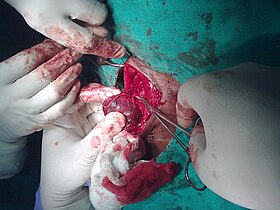
Back استئصال الدرقية Arabic Tiroidektomiya Azerbaijani Tiroidectomia Catalan Thyreoidektomie German Θυρεοειδεκτομή Greek Tiroidectomía Spanish تیروئیدبرداری Persian Thyroïdectomie French כריתת בלוטת התריס HE Tiroidektomi ID
| Thyroidectomy | |
|---|---|
 Thyroid surgery | |
| ICD-9-CM | 06.3-06.5 |
| MeSH | D013965 |
A thyroidectomy is an operation that involves the surgical removal of all or part of the thyroid gland. In general surgery, endocrine or head and neck surgeons often perform a thyroidectomy when a patient has thyroid cancer or some other condition of the thyroid gland (such as hyperthyroidism) or goiter. Other indications for surgery include cosmetic (very enlarged thyroid), or symptomatic obstruction (causing difficulties in swallowing or breathing). Thyroidectomy is a common surgical procedure that has several potential complications or sequelae including: temporary or permanent change in voice, temporary or permanently low calcium, need for lifelong thyroid hormone replacement, bleeding, infection, and the remote possibility of airway obstruction due to bilateral vocal cord paralysis. Complications are uncommon when the procedure is performed by an experienced surgeon.[citation needed]
The thyroid produces several hormones, such as thyroxine (T4), triiodothyronine (T3), and calcitonin. After the removal of a thyroid, patients usually take a prescribed oral synthetic thyroid hormone—levothyroxine (Synthroid)—to prevent hypothyroidism. Less extreme variants of thyroidectomy include:
- hemithyroidectomy (or unilateral lobectomy): removing only half of the thyroid
- isthmectomy or isthmusectomy: removing the band of tissue (or isthmus) connecting the two lobes of the thyroid
A thyroidectomy should not be confused with a thyroidotomy (thyrotomy), which is a cutting into (‑otomy) the thyroid, not a removal (‑ectomy, literally “out-cutting”) of it. A thyroidotomy can be performed to get access for a median laryngotomy, or to perform a biopsy. (Although technically a biopsy involves removing some tissue, it is more frequently categorized as an ‑otomy than an ‑ectomy because the volume of tissue removed is minuscule.)
Traditionally, the thyroid has been removed through a neck incision that leaves a permanent scar. More recently, minimally invasive and "scarless" approaches such as transoral thyroidectomy have become popular in some parts of the world. In the United States it is a common procedure, performed over 100,000 times per year. [1][2][3]
- ^ Sun GH, DeMonner S, Davis MM. Epidemiological and economic trends ininpatient and outpatient thyroidectomy in the United States, 1996 – 2006.Thyroid. 2013;23:727 – 733.
- ^ Rubio GA, Koru-Sengal T, Vaghaiwalla TM, Parikh PP, Farra JC, Lew JI.Postoperative outcomes in Graves’ disease patients: results from thenationwide inpatient sample database.Thyroid. 2017;27:825 – 831.
- ^ Patel, Kepal N.; Yip, Linwah; Lubitz, Carrie C.; Grubbs, Elizabeth G.; Miller, Barbra S.; Shen, Wen; Angelos, Peter; Chen, Herbert; Doherty, Gerard M.; Fahey, Thomas J.; Kebebew, Electron (March 2020). "The American Association of Endocrine Surgeons Guidelines for the Definitive Surgical Management of Thyroid Disease in Adults". Annals of Surgery. 271 (3): e21 – e93. doi:10.1097/SLA.0000000000003580. ISSN 0003-4932. PMID 32079830.